 |
|
The tomb of Emperor Yang Guang (AD 569-618) was recently unearthed in Yangzhou, Jiangsu province. [Photo provided to China Daily] |
"Some parts of Yang's tomb have collapsed and it was visited by grave robbers, which could explain why his remains were not as well preserved as Empress Xiao's," says Shu Jiaping, director of Yangzhou's archaeological bureau. "Also, the acidic soil of the Yangtze Delta is not good for preservation of remains."
|
|
Liu Qingzhu, a researcher from the institute of archaeology under the Chinese Academy of Social Sciences, says Emperor Yang rested in a shabby tomb because he had lost his identity as an emperor when he was buried by the founders of the next dynasty - the Tang Dynasty (AD 618-907).
"As an emperor of a dead empire, Yang couldn't be buried in a mausoleum that had the structure of a normal monarch's," Liu says.
Still, a large number of rare treasures were unearthed from the two tombs, including some that could only be used by royal family members.
More than 300 treasures made of jade, bronze, iron, pottery, wood and lacquer in various forms, including animals, soldiers and a snake-shaped man with two heads, were found in the two tombs.
Among them a 13-ring jade belt decorated with gold is considered of extreme value. Xu Guobin, deputy director of the archaeological bureau in Yangzhou, says it is the most complete jade belt unearthed in China, and the belt could only have been used by people with the highest social status.
Also, four lion-shaped doorknockers made of gold and bronze with a diameter of 26 cm, and 36 ancient percussion instruments made of bronze bells and L-shaped jade plates are considered to be important relics.
The discovery of Emperor Yang's real tomb leaves another mausoleum, which had been considered as the imperial burial site for about 200 years, in an awkward position.
The fake mausoleum, which is about 6 km away from the two tombs, has magnificent memorial arches, tomb doors and walls, and occupies an area of 30,000 square meters. It had been thought to be Yang's burial site since the Qing Dynasty (1644-1911) and been a tourist attraction in Yangzhou since the 1980s.
